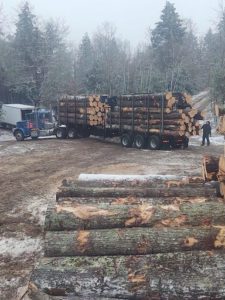Owning forest land is a rewarding long-term investment. You can earn income and generate economic value locally regularly by growing, harvesting, and selling your timber. You can decide to sell your timber any time, but how can you find out your timber’s worth to make sure it’s the right time? Or even to find out if it’s worth selling at all?
It can be really daunting to try to figure it out. William A. Day Jr. & Sons is a logging company here to guide you through the process. We are a large team of timber industry professionals who can handle both the harvesting and timber selling process for you.
Here are some tips and guidelines for gauging the relative value of your timber and the process that follows in selling your timber.
 What’s Your Main Objective When Selling Timber?
What’s Your Main Objective When Selling Timber?
Before you begin to gauge the worth of your timber, it’s important to assess why you are selling it. There can be many reasons, but the most common reasons are as follows:
- Many landowners want to make a profit by harvesting their trees. They can make relatively passive supplemental income with planned and managed harvests.
- Maybe you want to improve wildlife habitat. Healthy forests create habitats for wild animals and birds. Wildlife species need successional and young forest habitats for food and shelter. Mature forests also provide ample fawning and nesting cover for birds. Leaving strategic deadfall piles and clearings can significantly increase animal habitat and encourage biodiversity.
- Perhaps you’re looking to improve the health of your land. The number of dying and dead trees increases as the woodland matures. You can harvest ailing trees to revitalize and regenerate your wooded land.
- Maybe you want all of it. You can improve the overall health of your land, wildlife, and forest and profit in the process!
How Do You Find Out Timber Value?
Once you’re clear about your goals, you should determine the value of your timber. How much money can you make by selling your harvested timber? There’s no simple and accurate answer to this. There are many factors involved that determine the worth of timber.
For instance, the quality of trees, logging plan, species of trees, current timber demand and prices, and the age of the trees on your land. The value per tree also varies, depending on the ultimate use of the timber. For instance, selling a low-quality pine for pulp will typically result in a significantly lower price per tree than selling trees for construction lumber.
If you want to get the best profit on your timber, you should consult qualified loggers like Day Logging, who can help you harvest and sell your timber. You can reach out to us directly for timber selling and harvesting needs.
However, it’s difficult to determine the precise value of your timber on your own for the following reasons:
- Regional or state prices offer some level of pricing trend, but much of your timber worth depends on the local market. For instance, if you are near a lumber processing facility like a sawmill, you will obviously have less transportation cost and get more profit per tree than if you had to truck your logs hundreds of miles.
- Timber worth also depends on the quality, species, and sizes of trees, which is difficult for a layman to assess.
- Timber value also depends on the type of harvesting done and the amount of timber sold. Typically, the larger the sale amount, the higher the per unit prices. The cost of harvesting also influences timber’s worth.
- Profits also depend on the condition of the harvesting site. The cost of removing or hauling trees for processing eats into your profits. Distance from the site to the road and the condition of the routine will influence the value.
- Local and statewide timber harvesting regulations also affect timber selling. Your logger will have to consider the local population, wildlife habitat, and other such things before harvesting timber for sale.
Timber Selling: How To Do It Right?
You can also use other methods to find out what timber is worth. Such as:
- You can consult local or state personnel with local foresters or loggers in your area. You can find Forestry Department personnel in the local phone book. You can also visit the website for links to forestry and logging services.
- You can contact professional loggers that offer harvesting and timber selling services. We at William A. Day Jr. & Sons offer assistance with determining the value of your timber and timber selling.
- You can also examine timber prices in your state or surrounding areas.
Here’s what to consider when selling timber:
- Discuss everything ahead of timber selling. You can draft a contract with the buyer to be sure both parties are on the same page.
- Hire an insured logger to make sure they follow sustainable practices.
- Include how the service provider will manage the trees.
- The logger may also need to improve or clear logging trails. Include this in the contract, too, depending on the property.
If you have made up your mind about timber selling, look no further! William A. Day Jr. & Sons can handle the timber harvesting and selling process for you. We offer efficient timber harvesting services and help landowners sell timber at a valuable price in New Hampshire and Maine. Reach out to us today to find out what timber worth and make profits!
